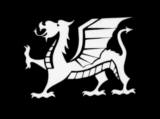


In principle Wales, with its clear cultural tradition different for its England neighbour, might expect a separate ITV company to serve it. Technical considerations rather than anything else made this difficult. Any transmitter for the most populous part of Wales would naturally be able to be received the other side of the Bristol Channel, and TWW had already been established on that basis. The consideration was whether TWW should be simply extended out into the rest of Wales, or whether a new company could take on that area. The Welsh Member of the ITA, J Alban Davies, pushed strongly for this, with a priority a significant amount of programmes in the Welsh language in peak as well as off-peak hours.
Initially two transmitters locations were considered to be needed for this service; one for Pembrokeshire and the other on the Lleyn peninsula, which could operate as a relay. However, 300,000 out of the 700,000 homes in the area covered by these would already receive fringe reception of TWW. The northernmost areas of Wales, such as Flint and Denbighshire would not be covered under this plan, and strong representations were made by various Welsh organisations that they should not be excluded. However, over 90% of the homes there already had satisfactory reception of Winter Hill, and this would be equivalent to providing them with an additional ITV station, at a time when the future of broadcasting was being determined by the Pilkington Committee.
In the end the contract was advertised with this question left open.
Just four days before the interview date it was made clear by the Post Office that 'a distinctly Welsh' service would be needed, and that half of the material should be locally originated.
For the Government, in the guise of the Post Office, to directly interfer with the workings of the ITA was unheard of, and the suggestion was rediculous. The four groups who had applied were nevertheless informed of these expectations. The groups were:
... not to be confused with
All were somewhat taken aback by the new conditions, with all the risks that this brought. Television Wales Norwest and Teledu Cymru were called back for a second interview, and after further financial checks Teledu Cymru gained the award. The conditions were less hard than the Post Office had originally insisted on, but the company would still need to provide ten hours of Welsh language and interest programmes during peak hours. The original intention was that Teledu Cymru would produce 4.5 hours, the remainder coming from TWWand Granada.
The final franchise area of ITV came into being on 14 September 1962. A deal had been struck with TWW to give free access to its Welsh language output. However, Granada had taken a decision to cease Welsh language programmes as it no longer saw North Wales as part of its obligation, and the shortfall had to be made up from WWN.
WWN had to demonstrate its viability in about 18 months prior to the
general franchise round. The fact that at least 70% of the population
in its area were already watching an alternative ITV station would make
this a difficult proposition, as they would need to buy a new aerial
and be able to at least understand Welsh for about one fifth of the
programmes. The first night remained local for the first hour, with
news and current affairs programmes in Welsh and English, before
showing Take Your Pick
at 19:00.
Although the standard of the local programming was thought to be generally good, with the Welsh content at the required level, the financial position of the station was never good. Advertising revenue per viewer was half that of a typical ITV company. The main difficulty was getting viewers to equip themselves in the first place, not helped by the lack of interest shown by wired-relay (cable) companies (numerous in the Welsh Valleys), who continued to carry TWW or even Westward.
The ITA, who had already deferred the WWN rental payment, wrote it off altogether, and by that stage the company was already over a quarter of a million pounds in debt. It was hoped that the opening of Moel-y-Parc would see an upswing, but that failed to materialise, and by May monthly income was still only two-thirds of what had been expected, and insufficient to cover the running costs of the station, let alone the debt, even though by this time WWN was receiving all its network programmes for no cost. WWN ceased all its programme production and made large redundancies. The Postmaster General released WWN from its obligation to 10 hours of programmes in Welsh. The ITA concluded that WWN was not capable of continuing to exist, and started to develop a merger with TWW.
The terms were:
These terms were so generous that Lord Hill, recently arrived at the ITA remarked that if they weren't accepted `a trainload of psychiatrists should be dispatched to Cardiff and points West and North'. They were accepted, and the merger took place in January 1964.
Presely 8H 14/09/62-25/01/64* Arfon 10H 09/11/62-25/01/64* Moel-y-Parc 11V 28/01/63-25/01/64*
* Date prior to takeover by TWW.



